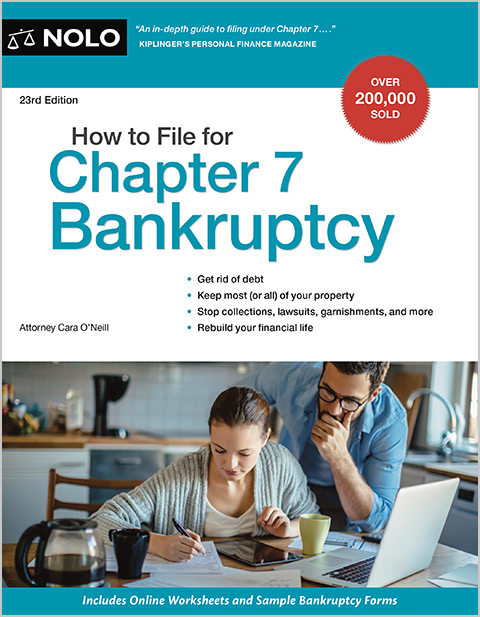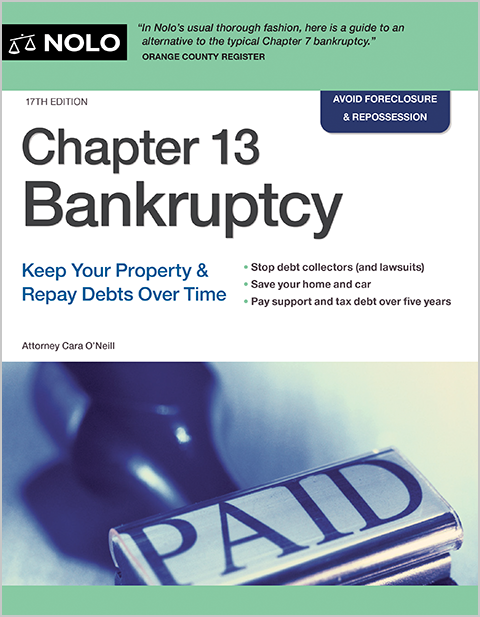Bankruptcy clears car loans in Chapters 7 and 13, but you'll lose your vehicle if you don’t make your payments and meet other requirements.
You need a vehicle to get to work, school, and medical appointments, so when considering bankruptcy, it's crucial to know what happens to your car when you file Chapter 7 or Chapter 13. Fortunately, most people can keep a vehicle in both bankruptcy chapters. In this article, you'll learn what you must do to keep your vehicle when filing for bankruptcy and what happens if you file for bankruptcy with a car loan.
- If I File Bankruptcy, What Happens to My Car?
- Does Bankruptcy Clear Car Loans?
- Can I Keep a Car in Bankruptcy Chapters 7 and 13?
- How Do I Keep My Car in Chapter 7?
- What Happens to Car Loans in Chapter 7?
- Can I Return the Vehicle in Bankruptcy and Get Out of a Car Loan?
- How Chapter 13 Bankruptcy Can Help You Keep a Car
- Need More Bankruptcy Help?
If I File Bankruptcy, What Happens to My Car?
Whether you can keep a car will depend on its equity amount, the exemptions available to protect it, and whether you choose to file for Chapter 7 or 13. Whether you're current or behind on your car payment will also impact your ability to keep your car.
Does Bankruptcy Clear Car Loans?
Yes, bankruptcy works by erasing or "discharging" car loans. However, even though bankruptcy will clear a car loan, you won't get a free car in bankruptcy. Although many people are under the mistaken belief that filing bankruptcy allows you to wipe out an auto loan and keep the vehicle free and clear of any payments, it isn't true.
Can I Keep a Car in Bankruptcy Chapters 7 and 13?
What you must do to keep a car in bankruptcy depends on whether you file for Chapter 7 or Chapter 13. In Chapter 7, you can keep the vehicle if you meet the following conditions:
- You can protect all the car's equity with a bankruptcy exemption.
- You're current on the car payment when you file.
- You can afford the car payment after bankruptcy.
Here's what you must show to keep a car in Chapter 13:
- You can afford to pay creditors through the Chapter 13 plan for any car equity you can't protect with a bankruptcy exemption.
- If you have a car loan, you can use the repayment plan to make the monthly payment and catch up on missed payments.
- You have enough income for all other Chapter 13 required payments.
Filers who meet these requirements don't need to worry about losing a car in bankruptcy. Keep reading to learn how to comply with the rules and the consequences if you can't.
How Do I Keep My Car in Chapter 7?
In Chapter 7 bankruptcy, you have two people to please before you can keep your car: the Chapter 7 bankruptcy trustee assigned to your case and the car lender. You'll need to do different things to satisfy each of them.
The Chapter 7 Bankruptcy Trustee and Your Car
The bankruptcy trustee won't take your car if you can protect all vehicle equity with a bankruptcy exemption. So, your first step would be determining whether you can protect your car's equity with a motor vehicle exemption. Check for a wildcard exemption if the motor vehicle exemption isn't enough to cover your equity. Many states let bankruptcy filers use both.
If you can protect all of the equity, you can keep the car in Chapter 7 bankruptcy, at least as far as the Chapter 7 bankruptcy trustee is concerned.
Example. When Henry filed for Chapter 7 bankruptcy, his car had $5,000 in equity. His state offers a $7,500 motor vehicle exemption, which more than covers his car equity. Because Henry can protect all vehicle equity, he isn't at risk of losing his car to the trustee.
Your Car Lender and Your Car in Chapter 7
To steer clear of your car lender in Chapter 7 bankruptcy, you must be current on your car loan when you file and remain current after your Chapter 7 case ends. Otherwise, the lender will be able to repossess the vehicle.
Example. Henry was five months behind on his car payment when he filed for Chapter 7 bankruptcy. So, even though he could protect the vehicle equity with a bankruptcy exemption, he still lost the car. Shortly after filing for bankruptcy, the lender filed a motion asking the court to lift the automatic stay and let the lender repossess the car. Because Henry was significantly behind on the payments—the vehicle's equity didn't cover the overdue amount—the bankruptcy judge granted the motion, and Henry lost the car.
Other Ways to Keep a Car With a Loan in Chapter 7
Additional options for keeping a car in Chapter 7 bankruptcy exist when you have a car loan. For instance, you can "redeem" the vehicle, which involves paying the lender its actual value.
What Happens to Car Loans in Chapter 7?
So why must you continue making your car payments to keep your car when filing for bankruptcy? The answer is that while bankruptcy erases car loans, it doesn't eliminate car liens.
Your car loan is the contract holding you responsible for paying for the car. The lien is the recorded document that allows the lender to reclaim the vehicle if you don't pay according to the contract terms.
Your Car Loan Gets Discharged in Bankruptcy
Bankruptcy works by breaking the contract requiring you to repay the lender for the car loan. You can file for bankruptcy, return the car to the lender, and not pay anything further on the car loan.
The Lien Against the Car Remains After Bankruptcy
However, there's a catch if you want to keep a car with a car loan. Filing for bankruptcy doesn't eliminate the lien that gives the bank the right to take back your vehicle if you don't pay as agreed. The bank can use the lien to repossess the car once the bankruptcy case is over, or sooner with the court's permission, even though you erased the debt. So if you want to keep the car, you must pay for it.
Example. Conroy asked his bankruptcy lawyer why he'd lose a car if he filed for Chapter 7 bankruptcy when behind on car payments, but not any of the things he purchased on a major credit card. His lawyer explained that Conroy agreed to give the car lender a lien against the car, which allows a car lender to recover the purchased property. He further explained that typically, major credit cards are "unsecured" and aren't guaranteed with a lien.
The lawyer also ensured Conroy understood that the vehicle lender could take the car after gaining permission to proceed during Chapter 7 from the bankruptcy judge or wait to repossess it after the Chapter 7 case ends.
Can I Return the Vehicle in Bankruptcy and Get Out of a Car Loan?
Sometimes, the best option is to return a vehicle with a car loan to the lender. Then you'll be entirely out from under the car loan. Many bankruptcy filers will return a financed car to the lender when they:
- paid too much for the vehicle
- can't afford the monthly payment, or
- don't want the vehicle or the car loan associated with it.
If you're in this situation, you'll check the box stating that you plan to "surrender the property" when filling out the Statement of Intention for Individuals Filing Under Chapter 7 form. You can also surrender a car with a car loan in Chapter 13 bankruptcy.
How Chapter 13 Bankruptcy Can Help You Keep a Car
If you're behind on your payments, consider filing for Chapter 13 bankruptcy. In a Chapter 13 repayment plan, you can pay off the vehicle balance over three to five years and keep the car.
But suppose you don't make the payments or catch up on any loan arrearages. In that case, the lender can repossess your car in Chapter 13 bankruptcy. Learn more about your car in Chapter 13 bankruptcy.
Need More Bankruptcy Help?
Did you know Nolo has made the law accessible for over fifty years? It's true, and we wholeheartedly encourage research and learning. You can find many more helpful bankruptcy articles on Nolo's bankruptcy homepage. For instance, Nolo articles will explain what bankruptcy can do, what you'll want to avoid before filing for bankruptcy, and more. Information needed to complete the official downloadable bankruptcy forms is on the Department of Justice U.S. Trustee Program website.
However, online articles and resources can't address all bankruptcy issues and aren't written with the facts of your particular case in mind. The best way to protect your assets in bankruptcy is by hiring a local bankruptcy lawyer.
- If I File Bankruptcy, What Happens to My Car?
- Does Bankruptcy Clear Car Loans?
- Can I Keep a Car in Bankruptcy Chapters 7 and 13?
- How Do I Keep My Car in Chapter 7?
- What Happens to Car Loans in Chapter 7?
- Can I Return the Vehicle in Bankruptcy and Get Out of a Car Loan?
- How Chapter 13 Bankruptcy Can Help You Keep a Car
- Need More Bankruptcy Help?

